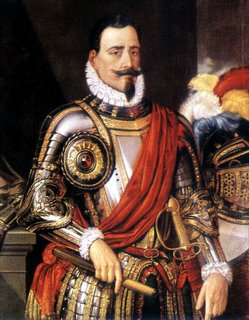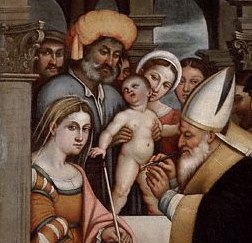January 1
 Spain did not adopt the Gregorian calendar until 1582, which means that 1 January 1554 did not mark the official start of the New Year. As he faced death that day, Pedro de Valdivia probably did not find much comfort in the knowledge that he would not, at least, begin the year on a bad note. Valdivia, the conquistador who took possession of Chile and was eventually rewarded with the title of governor, had spent the last years of his life in the vain and customary pursuit of territory and riches in the lands south of Peru. His efforts were not unopposed by the locals, who were less than enthusiastic about the intentions of their new neighbors. They destroyed Santiago -- the first city founded by Valdivia -- on 11 September 1541 and continued to obstruct the Spanish conquest for decades to come. At the battle of Tucapel, a week-long contest that began on 25 December 1553, Valdivia was captured by Mapuche Indians resisting Spanish encroachment. On January 1, molten gold was poured down the governor's throat. Whether he died of asphyxiation or internal bleeding, Pedro de Valdivia's death must have been excruciating.
Spain did not adopt the Gregorian calendar until 1582, which means that 1 January 1554 did not mark the official start of the New Year. As he faced death that day, Pedro de Valdivia probably did not find much comfort in the knowledge that he would not, at least, begin the year on a bad note. Valdivia, the conquistador who took possession of Chile and was eventually rewarded with the title of governor, had spent the last years of his life in the vain and customary pursuit of territory and riches in the lands south of Peru. His efforts were not unopposed by the locals, who were less than enthusiastic about the intentions of their new neighbors. They destroyed Santiago -- the first city founded by Valdivia -- on 11 September 1541 and continued to obstruct the Spanish conquest for decades to come. At the battle of Tucapel, a week-long contest that began on 25 December 1553, Valdivia was captured by Mapuche Indians resisting Spanish encroachment. On January 1, molten gold was poured down the governor's throat. Whether he died of asphyxiation or internal bleeding, Pedro de Valdivia's death must have been excruciating. Over the next three centuries most of the mineral wealth of Central and South American would continue to flow -- figuratively, at least -- into Spanish bellies, where they fattened one of the most powerful European empires of the last millennium.
***
 According to Christian tradition, January 1 also marks the eighth day after Jesus' birth -- the day on which, by Jewish custom, he would have been circumcised. For centuries after his crucifixion, Jesus' foreskin remained an object of peculiar veneration, with as many as 18 different reliquary nubs of flesh circulating throughout the landscape of Europe by the 16th century. Like most Catholic relics, the Holy Prepuce was believed to possess extraordinary powers -- in this case, the Christ child's foreskin was believed to enhance fertility and sexuality. In 1421, the English King Henry V brought one of the rumored foreskins from the French village of Coulombs to aid his wife, Catherine of Valois, in the delivery of their first son. Alas, while the relic may have helped bring the future King Henry VI into the world, it did Henry V little enduring good. He died less than a year later.
According to Christian tradition, January 1 also marks the eighth day after Jesus' birth -- the day on which, by Jewish custom, he would have been circumcised. For centuries after his crucifixion, Jesus' foreskin remained an object of peculiar veneration, with as many as 18 different reliquary nubs of flesh circulating throughout the landscape of Europe by the 16th century. Like most Catholic relics, the Holy Prepuce was believed to possess extraordinary powers -- in this case, the Christ child's foreskin was believed to enhance fertility and sexuality. In 1421, the English King Henry V brought one of the rumored foreskins from the French village of Coulombs to aid his wife, Catherine of Valois, in the delivery of their first son. Alas, while the relic may have helped bring the future King Henry VI into the world, it did Henry V little enduring good. He died less than a year later.Over time, the absurdity of the Holy Foreskin grew too great for even the Catholic Church to ignore. After 1900, the Church issued an edict than any discussion of the Holy Prepuce would result in excommunication and shunning; since the Vatican II reforms of the 1960s, Roman Catholics have not officially recognized the Feast of the Circumcision, choosing instead to acknowledge the Solemnity of St. Mary. The last public appearance of one of Jesus' alleged foreskins took place in the Italian village of Calcata, which had hosted the tip of the Redeemer's penis since 1557. Residents of Calcata and Catholic pilgrims continued to celebrate the Feast of the Circumcision until 1983, when thieves absconded with the foreskin and the jewel-encrusted box that contained it.